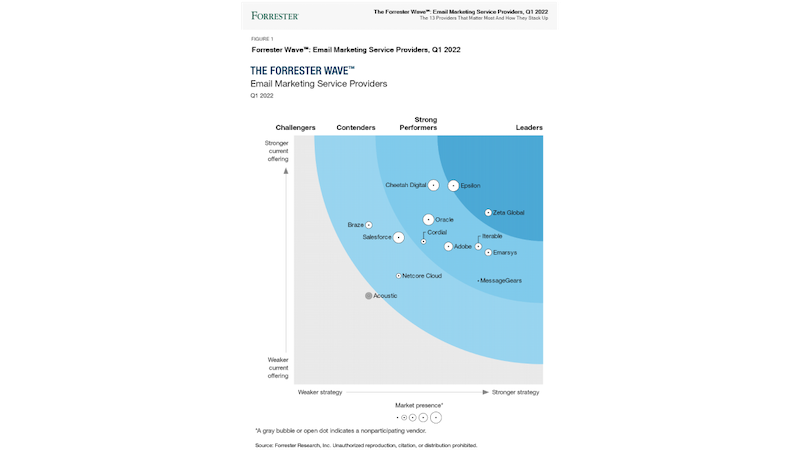
What to Look for in an Email Marketing Platform or an Email Service Provider in 2024
Plus RFP tips on how to choose the best platform for your business
Maybe you’ve outgrown your current email vendor.
Perhaps your business goals surpass your current platform’s capabilities.
Or you’re just trying to stay current and competitive.
Regardless of your reasons for evaluating a new email platform, the process usually calls for a request for proposal (RFP). But the market has changed significantly in the past couple of years.
Do you know what to look for in an email marketing platform today? How to structure your RFP so you end up with actionable information? And ultimately, how to choose an email marketing platform that truly meets your needs?
The typical RFP process for email marketing platforms is broken—but we have some tips for fixing it.
Why the Typical Email Marketing RFP Process is Broken
RFPs for email marketing platforms (EMPs) and email service providers (ESPs) typically start with a problem statement. The remainder is a litany of feature and function requests.
Do you have this feature or not?
If not, is it on your roadmap?
And how much will it all cost?
Then, brands invite their favorite vendors to participate in the RFP.
Brands often take this approach because they’re trying to create an apples-to-apples comparison between email vendors and platforms. But it ends up becoming a “bake off” to determine which vendor has more of the functionalities you need—for the least amount of money.
What are the problems with this RFP process?
Risk #1: The devil is in the details
As Chris Marriott, President and Founder of Email Connect, explained, “Shockingly, every vendor is going to put yes to every single one [feature].”
The vendors participating in your RFP may, in fact, have every feature you’re requesting — but the devil is in the details of the functionality. It’s important to understand how these features work, how much of an internal lift it will be to use them, and what sort of support is available.
And these details aren’t often provided via a traditional email vendor RFP.
For example, you may have a requirement that your email service provider offers creative and strategic services. Most vendors will say ‘yes, these services are available.’
But how comprehensive are those services? Are they delivered via the vendor’s company, or are they outsourced to a third party?
Or you may be looking for an email platform that can do immediate email distribution for efforts like flash sales. But some vendors can make this happen faster than others. And some can only scale so much, limiting the number of emails that can happen at the desired speed.
The takeaway is that it’s extremely important to understand how functionality and services are delivered.
Risk #2: You don’t actually need all these features
Brands will often include every single feature they think they may eventually need in their email vendor RFP.
But chances are, they may never use many of them.
“Nine times out of 10, they’re not even using all the features a platform has,” explained Kara Trivunovic, Group Vice President at Zeta Global. “Sometimes, they don’t even use the features they’re asking for. They just want to know they’re there on the off chance that, at some point in time, they may want to use them.”
Kara elaborated, “My husband got a Tesla and he paid for the auto drive functionality, but he has never used it because he doesn’t want to relinquish control of the car—so why did we buy it?”
Plus, if you’re looking for a full-service email provider, it’s more important to understand whether the provider can help you to achieve your objectives. It’s less important to understand which features they use to do so. If you focus too heavily on a feature list, you might end up with more of a self-serve platform rather than a full-service partner.
It’s particularly important to make sure any feature requirements from IT and procurement teams make sense for the business’ use cases and goals. These teams may add requirements that knock two-thirds of the vendors out of the running. And more times than not, they’re not fully informed about what they should be shopping for.
Risk #3: You’re making assumptions about foundational functionality
On the flip side, we’ve seen brands neglecting to include what they consider to be table stakes functionality in their RFPs. As the industry evolves, some of the new players don’t include the features you have become accustomed to.
For example, one platform that recently entered the space does not allow you to export your unsubscribes. This is basic functionality that most brands would assume all email platforms support. Others limit your ability to pull customer data out of the platform by capping the number of records in a given time period.
“There are things that brands have gotten really used to that some of these other ESPs actually don’t offer—and you don’t even think to ask,” said Trivunovic. “Your functional checklist starts to fail you because of these assumptions.”
Risk #4: Pricing is inaccurate via this process
Of course, email platforms and ESPs should be willing to provide pricing during the RFP process. Unfortunately, pricing can be nearly impossible for a vendor to scope from a feature requirements list.
“You [vendors] often haven’t even spoken to the brand yet, you don’t have a lot of familiarity with them, and you’re basing the pricing off of a single document that has little useful information,” said Trivunovic.
This process also tends to penalize platforms and ESPs that offer more inclusive pricing. For example, some vendors include deliverability in their costs, while others pull it out separately.
Let’s go back to that example of looking for a vendor that can support immediate distribution for flash sales. Some platforms and ESPs may charge based on how fast you want your emails to leave the system, but it’s extremely rare that a brand will include that detail in an RFP.
Ultimately, any pricing vendors provide based on an initial requirements list is a ballpark at best—and can change dramatically when the vendor eventually gets a more comprehensive picture of what you actually need for your email program.
4 New Table Stakes to Look for In an Email Marketing Platform
Choosing the right EMP or ESP means focusing less on an extensive feature list—and asking more of the right questions. When searching for a modern, enterprise-level email marketing solution, you should look for a few essential capabilities, as well as a handful differentiators that will future-proof your decision.
Yes, you still need to look for capabilities around personalization, dynamic content, sending transactional emails versus batch emails, etc. But anyone evaluating ESPs in 2024 should also be looking for the comprehensive capabilities around these four new table stakes:
1. AI and ML native to the platform
The first piece of this puzzle is determining how artificial intelligence (AI) and machine learning (ML) capabilities are built into the platform to make the marketer’s life easier and optimize your processes.
For example, can the platform surface recommendations about which audiences are ready for an offer? What type of offer the audience will be most receptive to? Or can the platform generate subject lines that will perform well with the audience and determine optimal send times? This is called behavior optimization.
The second aspect of AI/ML is understanding how the technology can create unique experiences for your consumers and help you to optimize your programs. How does the platform use AI and ML to drive personalization or optimize the next best offer and channel?
2. Audience- and signal-driven action
How does the platform or ESP use consumer signals and intent to initiate communications, rather than relying solely on pre-planned customer journeys?
For example, any email platform can create a customer journey that targets an audience of people who recently bought Teslas. As long as they have the data, they can initiate a set of prescribed communications to these consumers. But it’s pre-scripted, and it’s a prescribed journey. If the Tesla owner does X, send them Y.
But the reality is that people don’t follow prescribed journeys. Your email platform should be able to listen to customer signals and infer intent—then use those insights to inform the conversation. Predict what the consumer is going to need, provide it in the moment they need it, rinse and repeat. The dialogue should be consumer directed, not marketer directed.
“Sometimes, by the time you’ve got the data processed and the decision is made, you’ve missed the opportunity,” says Trivunovic. “And so you must be thoughtful about not only how you respond, but how quickly and how close to real time can you actually facilitate a response.”
3. Predictive intelligence and scoring
Not all signals are created equal. One consumer might conduct three relevant Google searches, while another conducts a Google search, fills out a form, and clicks an ad. While each consumer has provided three signals, the second consumer should score higher in terms of intent.
Your email marketing platform should be able to score individuals and audiences in real time—using intent-based signals and identifiers drawn from top activities and behavior.
4. Automated decisions and triggers
While audience- and signal-driven action is an important capability, you still want your platform to support automated decisions and triggers. When a consumer does X, take Y action.
It might sound like, well, every platform does that—and yes, every platform does it to an extent. But how complex are the triggers that you can put in place? How deep is the behavior that you can program against?
5 Differentiators That Matter In Your ESP Decision
Many of the table stakes we mentioned are still not status quo among ESPs. And yet, we haven’t even covered real differentiators. Enterprise brands that want to choose a future-proof email marketing solution must also look for the following five differentiating capabilities:
1. Ability to expand beyond the email platform
Some of the programs you’re trying to execute with your email marketing tools require strong, fast integrations with other platforms and data sources, like your CDP and DMP.
Success with these programs often comes down to your ability to make those data sources available in your email platform instantly. You also need to be able to make connections between those data sources through an identity graph for unified customer profiles.
A vendor that can offer you both ESP and CDP functionality, as well as flexibility to engage with other vendors, is better positioned to connect these data sources than point solutions.
“If you look at the number of martech vendors from 10 years ago versus now, it’s insane,” said Trivunovic. “It’s almost impossible for a brand to try to be the conduit of bringing all of those things together. It’s more and more important to either have one vendor who can make it all happen—or a very limited number of vendors with one that orchestrates connections to the others.”
2. Quality and quantity of data sources and identity resolution
Of course you want to know how many data sources your email platform can incorporate—but the quality of those sources is just as important as the quantity.
For example, how fast can you process outside data sources for use in an email campaign? Every provider will say this happens in real time, but not every ESP defines real time in the same way (remember, the devil is in the details).
And when it comes to identity, how many data points can you accommodate in your identity graph? Is identity based solely on cookies? Is it an audience with first-party permissions? How does the platform handle identity resolution, or resolving various data points into a single customer? Can you make connections between known and anonymous people online?
Your email marketing platform or provider should provide both powerful, real-time data processing capabilities, as well as an actionable single view of customers that’s rigorously maintained and enriched with insights and signals.
3. Take action on meaningful signals in real time
Data and insights don’t have much value if you can’t act on them in the moments that matter. While audience- and event-driven communications should be table stakes, the real differentiator is an ESP that can use signals to predict your next best action and help you execute on it.
You could send an audience-driven email, for example, to people that you know like pizza or have ordered from your pizza company in the past. But with signal-driven communications, you might see that certain people that like pizza also frequently order take-out on Friday evenings — and choose to send them a promotional offer just before their typical order times.
The best email marketing platforms and providers proactively surface these recommendations so you can continually improve your performance.
4. Omnichannel activation
It’s easy to understand personalization in the framework of email, but how can you effectively extend that personalization to other channels? How does your email marketing platform help you execute personalization in a coordinated way across email, social, SMS, and digital advertising, for example — without bombarding the consumer with messaging?
Signals are again key to success when activating across channels.
The best email marketing platforms can determine the best channels for particular audiences and efforts, based on the most effective use of each channel, as well as individuals’ behaviors and preferences. These platforms will also help you to determine the best moments to send communications in each channel for optimal performance, based on when individuals are most likely to respond.
For example, some of our pizza lovers might be more likely to respond to a text offer for free delivery versus an email with the same. Your platform should be able to give you this insight and help you activate against it.
5. Business-level measurement and insights
Most email marketers measure their success by email marketing campaign performance. Some of the most common KPIs include click-through rates, open rates, conversion rates, sales—you know the drill.
But these metrics don’t typically speak to success when it comes to building relationships and loyalty. They don’t measure the impact of your efforts on improving the health of the business. And they typically only offer a lookback on past performance.
Instead, consider what measurement, insights, and intelligence you would need to drive business growth in the future.
How successful are you at building loyalty with a particular consumer or your consumers in general? How can you determine the predictive lifetime value of a customer, rather than just looking at what a customer has spent in the past? What is a given person’s propensity to engage with the organization and what are the steps you need to take to support that journey?
Your ESP should be able to provide forward-looking business insights that actually move the needle for your brand.
How to Choose the right ESP: Tips for a Better RFP Process
If the traditional RFP process is broken, how do you find the right email provider that offers the table stakes and differentiators you need? There are a few ways you can make the RFP work better for you—and your vendor prospects.
1. Determine which vendors to include in your RFP
There isn’t a best ESP, but there is a best ESP for every brand. And if you invite the wrong ESP into your RFP, you’re immediately getting off on the wrong foot. You’ll waste time evaluating vendors that are not a good fit, and worse, you could end up signing a contract with a vendor that doesn’t suit your needs.
“If you just go out and pick ESPs based on what you’ve heard about them or who’s talking about them, the likelihood of including an ESP that isn’t a good fit in your RFP goes up exponentially, and that can lead to very bad outcomes down the road,” explained Marriott.
The solution is to first thoroughly understand your company’s needs and requirements for an email marketing solution.
Unfortunately, creating a requirements document is a long and tedious process and there are no shortcuts to getting it done well. But there are some best practices that will help you to ensure you get the information you need to begin whittling your list:
- Be sure to include both the table stakes and differentiators that will future-proof your email platform.
- Use open-ended questions that encourage detail and tease out the “how” of the features and functionality. You may even consider sharing your use cases and asking each vendor to provide quick videos of how each use case would play out in their platform.
- Include everybody who has a stake in the decision and allow them input on the requirements. That includes various departments (e.g. marketing, IT, customer service, procurement, etc.), as well as various levels (a VP will have different requirements than a marketing manager).
“[One] thing that can absolutely detonate an RFP is to leave people out of the process early on,” warned Marriott. “They can come in later in the process, roll the hand grenade into the room, and blow it all up because they haven’t been involved.”
Once you have a clear requirements document, choose six to eight vendors that are mostly likely to fit those criteria.
For more advice from Marriott on choosing vendors, see our video series The Best RFP Leads to the Right ESP episode 1: Choosing the Right Vendors.
2. Use a scorecard to guide your first round of cuts
The most objective way to evaluate your shortlist of email vendors against your requirements list is to use a scorecard. It’s normal for everyone and every department to have their own vendor biases. Choosing an email service provider via a scorecard approach ensures that these biases are not the determining factor in your decision.
Plus, the scorecards provide a paper trail. Marriott explained:
“Having a paper trail at the end of the process is hugely valuable when the CMO finally pokes his or her head in and says, ‘why do you pick Vendor B?’. You’ve got scorecards to say, ‘well, because fifteen well-regarded people at your company scored them all, and that’s where we arrived.”
Follow a few best practices to drive an effective scoring process:
- Compile every vendor’s response to each question for easy side-by-side comparison.
- Have participants individually score each vendor on every response. Include at least 10 or 15 people in the scoring process that represent your various roles and functional departments.
- Tally the scores and eliminate all but the top four. These remaining four vendors will advance to the next step of the RFP, which includes more in-depth conversations and demos with each.
See what else Chris Marriott has to offer when it comes to scorecards. Watch The Best RFP Leads to the Right ESP episode 2: Creating a Scorecard.
3. Understand (accurate) pricing and determine value
First and foremost, do not ask for pricing in the first round of your RFP. As we’ve covered, it’s rarely accurate at this stage and may cause you to make ill-informed decisions. We recommend you ask for pricing after cutting your list to your four top vendors.
And when you do ask, you need to find a way to create an apples-to-apples comparison of your prospective providers — even if they all have different pricing models. At one point in time, the comparison largely centered around CPM (you were charged based on your volume of sent emails).
Fast forward to 2024, and email platform pricing has become much more complex. Many email marketing platforms now add various fees (e.g. storage fees) to account for the number of records in the database. These extra fees, which all have different names, make your pricing comparison more difficult.
“Many vendors make their CPMs artificially low and make up for it in the data storage fees or some other fees,” said Marriott.
The solution is not to focus on CPM or any other single line item in your RFP. Instead, roll up all costs required to achieve your goals into a single number. That single number gives you the most realistic estimate of what your costs will be and offers you the best apples-to-apples price comparison.
As you compare pricing, remember that the best vendor relationships will be those in which you feel you are getting good value for your money, AND the vendor feels they are being fairly compensated for that value. Marriott explained:
“You can poison the relationship right at the start if one side or the other feels like the negotiation or the initial contract isn’t in everybody’s best interest.”
For more advice on pricing and determining value, see our video The Best RFP Leads to the Right ESP episode 3: Pricing and Value.
The Best RFP for the Right ESP: Key Takeaways and Getting Started
If you made it this far, you’ve just consumed a LOT of information—let’s do a quick recap.
The landscape of email marketing platforms and email service providers has evolved significantly, and the traditional RFP process does not capture the nuanced information you need to choose an email marketing platform that’s ideal for your business.
It’s crucial to focus on your specific business needs and find an email marketing platform or email services provider that meets those needs, rather than listing every bell and whistle you might eventually want in a tool. Understanding the details of how each piece of functionality works is far more important than just ticking off boxes on a requirements list.
You can ensure you’re choosing a platform that will serve you well in the future by looking specifically for new table stakes capabilities (like native AI/ML capabilities and automated decision making), as well as differentiators (such as the ability to expand beyond email functionality, and omnichannel activation).
And when it comes to an effective RFP process, you’ll get the most actionable information by involving all stakeholders throughout all stages, using scorecards for objective evaluation, and comparing pricing based on total cost for value delivered.
If you’re ready to get started with an RFP for an EMP, ESP, or any other email marketing solution, download our RFP template.
Don’t forget to include Zeta in your shortlist (if appropriate for your needs!) — or better yet, just ask for a demo today.
Want to see Zeta in action?





